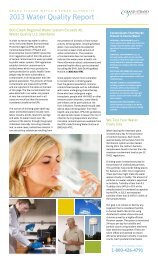Emergency Plan - Grand Strand Water and Sewer Authority
Emergency Plan - Grand Strand Water and Sewer Authority
Emergency Plan - Grand Strand Water and Sewer Authority
You also want an ePaper? Increase the reach of your titles
YUMPU automatically turns print PDFs into web optimized ePapers that Google loves.
<strong>Water</strong> System Contamination<br />
3.2.46. SITUATION<br />
EVENT SPECIFIC GUIDELINES 13(ESG-13)<br />
WATER SYSTEM CONTAMINATION<br />
GSWSA operates <strong>and</strong> maintains a number of water treatment <strong>and</strong> storage facilities, as well<br />
as a water distribution system consisting of several hundred miles of water mains.<br />
GSWSA relies on these facilities <strong>and</strong> systems to collect, treat, <strong>and</strong> transport safe drinking<br />
water to each <strong>and</strong> every customer.<br />
GSWSA’s water treatment, storage Consider <strong>and</strong> initial distribution operational systems are susceptible to<br />
Response actions (as appropriate)<br />
contamination in a number of different ways, ranging from accidental <strong>and</strong> minor to<br />
intentional <strong>and</strong> catastrophic.<br />
3.2.47. THREAT or HAZARD INFORMATION<br />
For the purpose of this procedure, anything other than potable water (completely safe for<br />
drinking, <strong>and</strong> meeting or exceeding all drinking water st<strong>and</strong>ards <strong>and</strong> regulations) entering<br />
GSWSA’s water system may be considered “contamination.” Some contaminants may<br />
present little or no potential consequences, while others may present extremely high<br />
potential consequences.<br />
Some of the possible ways that contaminants could be introduced into the water system<br />
include, but are not limited to:<br />
• draining in while the integrity of the system is compromised due to a leak or break<br />
<strong>and</strong> the subsequent repair operations.<br />
• being pulled in from back-siphonage during periods of low pressure, such as during<br />
major leaks / breaks, system flushing operations, or fire fighting activities.<br />
• being pushed in from pressurized systems that exceed <strong>and</strong> overcome our water system<br />
pressure.<br />
• failure or malfunction at a treatment facility resulting in inadequately treated water<br />
being distributed to the system.<br />
• intentional introduction of contaminant in an attempt to cause harm to GSWSA<br />
<strong>and</strong>/or its customers.<br />
3.2.48. CONCEPT of OPERATIONS<br />
Threat Warning: Potential water system contamination events begin with a Threat<br />
Warning. Threat Warnings are unusual events, observations, or discoveries that indicate<br />
there is a potential contamination incident.<br />
Threat Evaluation: A Threat Warning will typically result in a Threat Evaluation, which is<br />
an assessment to determine the credibility of the contamination threat.<br />
Threat Warnings can come from many different sources. The most common forms of<br />
Threat Warnings include:<br />
<strong>Gr<strong>and</strong></strong> <strong>Str<strong>and</strong></strong> <strong>Water</strong> & <strong>Sewer</strong> <strong>Authority</strong> 123 CONFIDENTIAL MATERIALS<br />
<strong>Emergency</strong> Management <strong>Plan</strong><br />
SECURITY SENSITIVE<br />
June 7, 2013<br />
NOT FOR PUBLIC DISCLOSURE






